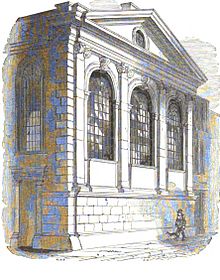St Michael's Wood Street was a church and parish of medieval origin in Cripplegate Ward in the City of London,[1] and is first mentioned in 1225 as St. Michael de Wudestrate.[2] It stood on the west side of Wood Street, initially with a frontage on Huggin Lane but later on Wood Street itself.[3]
| St. Michael Wood Street | |
|---|---|
 | |
 | |
| Location | London |
| Country | United Kingdom |
| Denomination | Church of England |
| Architecture | |
| Architect(s) | Christopher Wren |
| Style | Baroque |
| Demolished | 1897 |
The Medieval church edit
After King James IV of Scotland was killed at the Battle of Flodden in 1513, it is said that his head was brought to London and later buried in the crypt of this church.[4][5] John Stow admired the building, and called it a "proper thing."[6]
Rebuilding edit
The church was destroyed in the Great Fire of London,[7] and after some pressure[8] it was rebuilt by Sir Christopher Wren in 1673.[9]
The main facade toward Wood Street was described by Godwin as "a pleasing and well-proportioned morceau of Italian architecture", with four Ionic columns above a stylobate, supporting an entablature and pediment. The west side, towards Huggin Lane, was much plainer.[10] The tower was originally 90 ft high;[11] Henry Thomas, writing in 1828, noted that the tower seemed to have survived from the previous building, and that it had recently received a spire, increasing the overall height to 120 feet.[12]
George Godwin described the interior of the church as "a large and well-lighted parallelogram with a coved ceiling, but ... not ecclesiastical in any respect in its general appearance". The building was restored in 1831, at which time the tower was opened up into the interior of the church. There was a gallery at the west end and a reredos at the east end, with paintingsof Moses and Aaron.[10]
The organ was built by Thomas Elliot in 1800: the most noted organist was Dr Henry Hiles, who served during 1859.[13][14]
Demolition edit
In 1854 the declining residential population led to proposals to reduce the number of churches within the "Square Mile"[15] – a procedure the church's vicar had himself proposed.[16] The church was eventually demolished under the auspices of the Union of Benefices Act[17] in 1897,[18] and many bodies were disinterred from the churchyard and reburied at Brookwood Cemetery.[19]
The parish was then united with St Alban Wood Street,[20] and, after the destruction of that church in World War II, with St Vedast Foster Lane.[21]
The site has undergone several redevelopments: between 1994 and 2016 it was a pub called the Red Herring.[4][22]
Ministers of the church edit
- John Ive, fl 1399 [23]
- Arthur Jackson (minister), c.1624 [24]
Bibliography edit
- 'Church of England, Parish of St. Michael Wood Street. - Assessment of the annual tithes of the joint parishes of St. Michael Wood St, 1671'. - M0014588CL cited in City of London Parish Registers Guide 4
See also edit
References edit
- ^ 'Cripplegate, one of the 26 Wards of the City of London' Baddesley, J.J p41: London; Blades, East & Blades; 1921
- ^ H.A. Harben, A Dictionary of London (Herbert Jenkins, London 1922)
- ^ "The Survey of Building Sites in London after the Great Fire of 1666" Mills, P/ Oliver, J Vol I p7: Guildhall Library MS. 84 reproduced in facsimile, London, London Topographical Society, 1946
- ^ a b Dr. Tony Pollard (8 September 2013). "The sad tale of James IV's body". BBC News Scotland. Retrieved 9 September 2013.
- ^ G. Huelin, Vanished Churches of the City of London (Guildhall Library Publishing, London) 1996ISBN 0900422424
- ^ W. Thoms (ed.), John Stow's A Survey of London (A Whittaker & Co, London 1842) (original 1598).
- ^ Reynolds, 1922
- ^ A. Hallows (ed.), (London, Guildhall Library Research, 1974) ISBN 0-900422-30-0
- ^ M. Whinney, Wren (Thames & Hudson, London 1971) ISBN 0-500-20112-9
- ^ a b Godwin, George; John Britton (1839). "St Micheal, Wood Street". The Churches of London: A History and Description of the Ecclesiastical Edifices of the Metropolis. London: C. Tilt.
- ^ Hatton, Edward (1708). A New View of London: Or, An Ample Account of that City, in ... Eight Sections. J. Nicholson. p. 435.
- ^ Thomas, Henry (1828). The Wards of London: Comprising a Historical and Topographical Description of Every Object of Importance Within the Boundaries of the City. With an Account of All the Companies, Institutions, Buildings, Ancient Remains ... and Biographical Sketches of All Eminent Persons Connected Therewith. J. Gifford. p. 97.
- ^ Bridge, Joseph Cox (1912). . In Lee, Sidney (ed.). Dictionary of National Biography (2nd supplement). London: Smith, Elder & Co.
- ^ C.W. Pearce, Notes on Old City Churches: their organs, organists and musical associations (Winthrop Rogers Ltd, London 1900)
- ^ 'Proposed Removal Of Thirty City Churches', The Times, Wednesday 4 January 1854 (Issue 21629), p. 5, column F.
- ^ C. Hume, Proposal for supplying the Suburbs of London with some of the Churches not required in the City (London, 1853)
- ^ C. Hibbert, D. Weinreb and J. Keay, The London Encyclopaedia (Pan Macmillan, London, 1983) (revised 1993, 2008) ISBN 978-1-4050-4924-5
- ^ G. Cobb, The Old Churches of London (London, Batsford, 1942).
- ^ J.M. Clarke, The Brookwood Necropolis Railway (Oasdale, Usk, 2006) ISBN 978-0-85361-655-9
- ^ P. Norman, On the destroyed church of St. Michael Wood street in the City of London (The Society, London 1902)
- ^ J. Betjeman, The City of London Churches (Andover, Pitkin, 1972) ISBN 0-85372-112-2
- ^ Whatpub.com
- ^ Plea Rolls of the Court of Common Pleas: The National Archives (UK) CP 40/555, Year 1399 (first term of Henry IV), 4th entry, county margination "london": John Ive, parson, as plaintiff
- ^ Lambeth Library CM VII/34